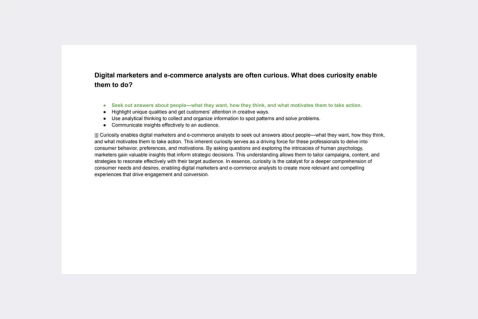A marketer enhances webpage results in Google Search by including interactive features and a star rating. How did they achieve these unique features?
By adding structured data to the page, which is code used to describe webpage content better to search engines
By adding structured data to the page, which tests whether the webpage uses valid markup
By adding structured data to the page, which provides additional machine-readable information within a webpage
By adding structured data to the page, which search engines use to display content in search results
Certification program: 👉 Google Digital Marketing & E-commerce Professional Certificate (Coursera)
Explanation: The marketer achieved interactive features and a star rating on the webpage results in Google Search by “adding structured data to the page, which provides additional machine-readable information within a webpage.” Structured data, often in the form of Schema.org markup, allows the marketer to embed specific details about the content on the webpage in a format that search engines can easily understand. This additional information enables search engines to present rich results, such as star ratings, reviews, and interactive features, directly in the search listings. By incorporating structured data, the marketer enhances the visibility and appeal of their webpage in search results, providing users with more context and encouraging higher engagement.
Passing exams is not a workout. Multiple attempts won’t make you stronger.



- All possible certificate program questions
- Real certification exam questions
- Detailed answer explanations.
- Over 1700 questions, 7 courses, 30 quizzes
- Free lifetime updates.
Elevating Your Google Search Results with Interactive Features and Star Ratings
In the competitive landscape of online search, standing out from the crowd and capturing users’ attention is essential for driving traffic and engagement to your website. One effective strategy that marketers employ to enhance webpage results in Google Search is by incorporating interactive features and star ratings. But how exactly do they achieve these unique features, and what impact do they have on search performance? Let’s delve into this topic and uncover some practical insights.
Incorporating Interactive Features
1. Rich Snippets and Structured Data
Marketers can enhance their webpage results in Google Search by implementing structured data markup, also known as schema markup. This markup provides search engines with additional context about the content on the webpage, enabling them to display rich snippets in search results. Rich snippets can include interactive features such as FAQs, recipes, events, product information, and more, making the search results more visually appealing and informative for users.
2. Interactive Widgets and Tools
Another way to incorporate interactive features is by embedding interactive widgets or tools directly into the webpage. This could include calculators, interactive maps, product configurators, quizzes, and other engaging elements that provide value to users and encourage them to interact with the content. By offering interactive experiences within the search results, marketers can capture users’ attention and drive them to click through to the webpage.
Adding Star Ratings
1. Schema Markup for Reviews
To display star ratings in Google Search results, marketers can utilize schema markup specifically designed for reviews and ratings. By implementing the appropriate schema markup on their webpage, marketers can provide search engines with structured data about the reviews and ratings associated with their products, services, or content. This enables Google to display star ratings alongside the webpage snippet in search results, increasing visibility and credibility.
2. Customer Reviews and Testimonials
In addition to schema markup, marketers can also leverage customer reviews and testimonials to generate star ratings in search results. Encouraging satisfied customers to leave reviews and ratings on platforms such as Google My Business, Yelp, and industry-specific review sites can boost the credibility and authority of the webpage. Positive reviews and high star ratings can influence users’ perception and encourage them to click through to the webpage.
Practical Insights for Implementation
-
Utilize Schema Markup: Take advantage of schema markup to provide search engines with structured data about your content, products, and reviews.
-
Offer Value: Create interactive features and tools that offer value to users and enhance their search experience.
-
Encourage Reviews: Actively encourage customers to leave reviews and ratings, and respond promptly to feedback to maintain a positive online reputation.
-
Monitor Performance: Regularly monitor the performance of your search results with interactive features and star ratings to assess their impact on click-through rates and engagement.
In conclusion, incorporating interactive features and star ratings into webpage results in Google Search can significantly enhance visibility, credibility, and engagement. By leveraging structured data markup, interactive widgets, customer reviews, and testimonials, marketers can create more compelling search results that drive traffic and conversions to their website.
Now, armed with these insights, how will you enhance your webpage results in Google Search with interactive features and star ratings to elevate your online presence and attract more users?
Discover our best-value guides
- Special Bundle Offer Google_Ads_Roll
- Special Bundle Offer HubSpot_Exams_Roll
- Special Offer Unchained_Guru_Roll
- Special Bundle Offer Amazon_Roll
- Special Bundle Offer Google_Analytics_Roll
- Special Bundle Offer Google_SkillShop_Roll
- Special Bundle Offer Marketing_Platforms_Roll
- Special Bundle Offer Microsoft_Advertising_Roll
- Special Bundle Offer YouTube_Roll
- Special Bundle Offer Google_Android_Roll
- Ultimate PMP certification preperation guide
- Google Cloud Professional Architect Certification Exam Answers - Ultimate Guide
- Special Bundle Offer SEMrush_Roll